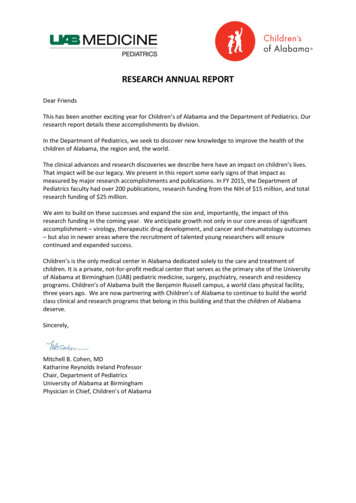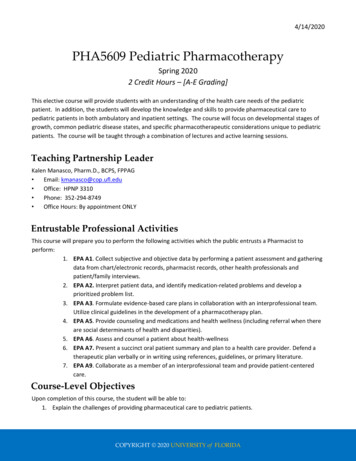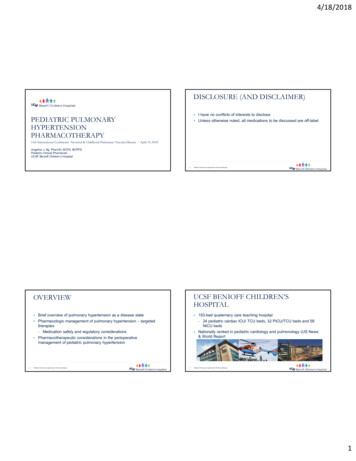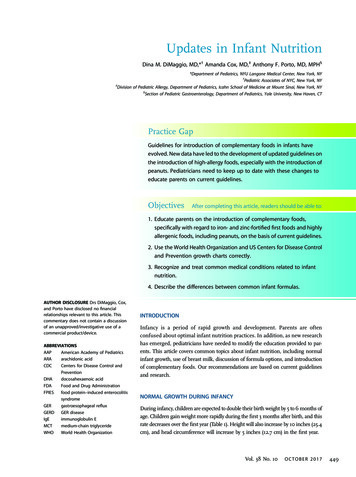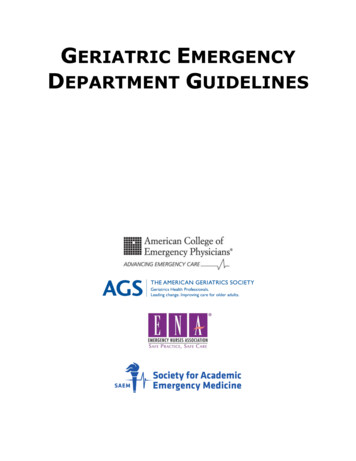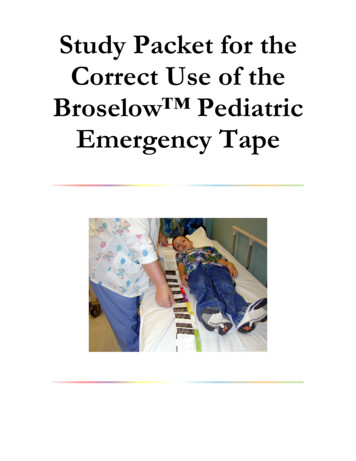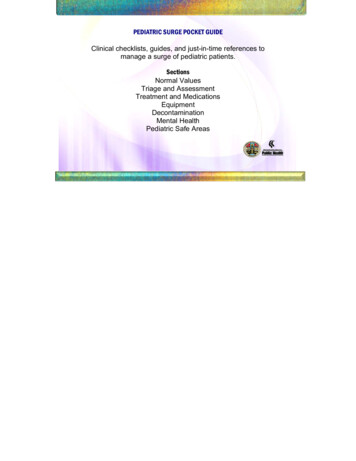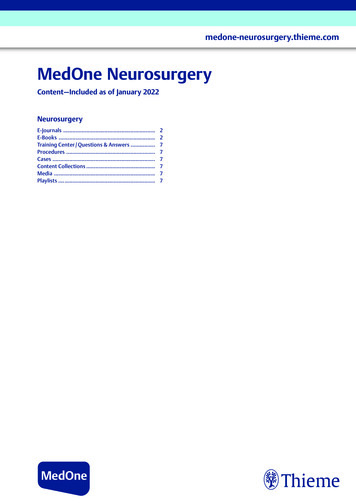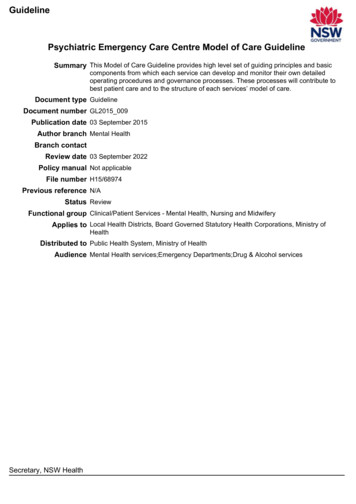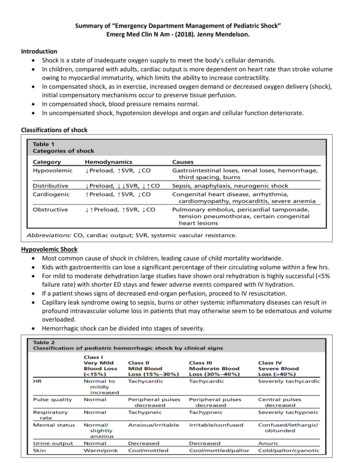
Transcription
Summary of “Emergency Department Management of Pediatric Shock”Emerg Med Clin N Am - (2018). Jenny Mendelson.Introduction Shock is a state of inadequate oxygen supply to meet the body’s cellular demands. In children, compared with adults, cardiac output is more dependent on heart rate than stroke volumeowing to myocardial immaturity, which limits the ability to increase contractility. In compensated shock, as in exercise, increased oxygen demand or decreased oxygen delivery (shock),initial compensatory mechanisms occur to preserve tissue perfusion. In compensated shock, blood pressure remains normal. In uncompensated shock, hypotension develops and organ and cellular function deteriorate.Classifications of shockHypovolemic Shock Most common cause of shock in children, leading cause of child mortality worldwide. Kids with gastroenteritis can lose a significant percentage of their circulating volume within a few hrs. For mild to moderate dehydration large studies have shown oral rehydration is highly successful ( 5%failure rate) with shorter ED stays and fewer adverse events compared with IV hydration. If a patient shows signs of decreased end-organ perfusion, proceed to IV resuscitation. Capillary leak syndrome owing to sepsis, burns or other systemic inflammatory diseases can result inprofound intravascular volume loss in patients that may otherwise seem to be edematous and volumeoverloaded. Hemorrhagic shock can be divided into stages of severity.
In an infant/toddler in shock with unclear etiology, consider occult hemorrhage owing to nonaccidentaltrauma.Distributive Shock Normal vascular tone becomes inappropriately relaxed. Vasodilation leads to effective hypovolemiaalthough a net fluid loss may not have occurred. Common causes:o Sepsis- massive inflammatory response along with nitric oxide and cytokine releaseo anaphylaxis- mast cell degranulation leads to vasodilatory cytokine releaseo neurologic injury (spinal shock)- sympathetic chain of autonomic nervous system disruptedresulting in unopposed parasympathetic vasodilationo toxicologic American College of Critical Care Medicine defines septic shock as a clinical diagnosis made whenchildren have suspected infection manifested by hypothermia or hyperthermia and clinical signs ofinadequate tissue perfusion including any of the following: decreased/altered mental status, abnormalcapillary refill time (CRT) or pulse characteristic, or decreased urine output ( 1 mL/kg/h). Hypotensionis not required for the clinical diagnosis of septic shock. Septic shock can present in one of two ways: cold shock or warm shock. Cold shock is characterized by high SVR resulting in cool/cold extremities, delayed CRT ( 2 seconds),diminished peripheral pulses or differential between peripheral and central pulses, and narrow pulsepressure. Warm shock is characterized by low SVR, with warm/dry extremities with brisk (“flash”) CRT,tachycardia, and bounding pulses with a wide pulse pressure.Cardiogenic Shock In children usually myocarditis or congenital heart disease or a cardiomyopathy Categories of heart failure and cardiogenic shock are classified by 2 traits: venous congestion (owing toincreased filling pressures) and hypoperfusion (owing to decreased cardiac output or myocardialcontractility).Hemodynamic Profiles in Pediatric Heart FailureWarm and dry: Normal perfusion and no congestion. Well-compensated but may have significant cardiac dysfunction.Cold and dry: Poor perfusion (cool extremities, weak pulses, narrow pulse pressure, delayed CRT, AMS,hypotension) without venous congestion. Decompensating. Sick appearing. Increased peripheral vascular resistance. May have oliguria and altered mental status.Warm and wet: Normal perfusion with venous congestion (edema, rales, ascites, JVD, S3 gallop) Still partially compensated. May benefit from diuretics or inodilators.Cold and wet: Poor perfusion with venous congestion. The sickest group of all. Usually requires inotropes. May require mechanical support.
Obstructive Shock Either pulmonary or systemic blood flow is impairedresulting in impaired cardiac output. May be intracardiac or extracardiac obstruction andmay be congenital or acquired. Examples: tamponade, pneumothorax, massive PE,severe pulmonary hypertension, hypertrophiccardiomyopathy, obstructive congenital lesions In infants, obstructive shock occurs when congenitallesions obstruct outflow of blood from the heart, requiring the systemic output to be supplied by thepulmonary artery system via the ductus arteriosus. When the ductus closes in the first few days or weeks after birth the infants present with severe shock. Obstructive shock requires prompt recognition and intervention (eg , prostaglandin therapy for aductal-dependent lesion, pericardiocentesis for tamponade, thoracostomy for pneumothorax.Recognition All infants under 3 mos presenting in shock are septic until proven otherwise. The history of a child in shock is often nonspecific with symptoms such as lethargy, fussiness, poorfeeding or decreased urine output. Children compensate for shock with tachycardia and increased SVR. Tachycardia is the most common presenting physical exam finding. Increased SVR manifests as delayed capillary refill time (CRT), diminished peripheral pulses. Prolonged CRT is highly specific but not sensitive for mortality. Prolonged CRT and hypotension portend a 26.9 mortality rate. Hypotension is defined as 5th percentile for age.Ultrasound ExamEvidence for use of POCUS in pediatric shock lags behind adults.Treatment Every child in shock should get supplemental oxygen. Continuous cardiorespiratory and pulse oximetry monitors. Peripheral IV access Check blood sugar and correct hypoglycemia.
Hypocalcemia (ionized calcium 1.1 mmol/L) should also be corrected.Fluid Resuscitation Treat signs of shock with a 20ml/kg bolus, even if BP normal, and give repeated boluses if systemicperfusion fails to improve. In neonates or suspected cardiogenic shock, use 10ml/kg boluses and reassess frequent for signs ofvolume overload (hepatomegaly, S3 gallop, pulmonary rales. Volume resuscitation in hypovolemia and sepsis requires 40-60ml/kg and may require as much as200ml/kg. Start vasopressors for children in shock after 60ml/kg of IV fluids. Fluid administration in shock should be as rapid as possible. This can be achieved with a push/pulltechnique using a 3 way stopcock and a large syringe or using a pressure bag (the two methods havebeen shown to be equivalent). 20ml/kg of fluid can be administered in 5 minutes or less via pressure bag or push methods. Central line unnecessary in children, at least in the initial stages. Peripheral or IO lines are fine.Vasoactive Medications Start vasopressors through whatever line is available (peripheral, IO, CVL). Extravasation rare in 2017 pediatric study (2%) with none requiring medical or surgical intervention. If peripheral iv used, dilute the vasopressor and check the line frequently. Epinephrine now the first line vasopressor for cold fluid-refractory shock with dopamine reservedwhen epinephrine is unavailable.
Vasoactive Medications continued Warm shock is seen much less commonly in children, norepi is recommended as first-line. Dopamine second-line.Intubation May be indicated for hemodynamic instability alone. Reduced work of breathing after intubation can reduce this oxygen consumption and divert criticalcardiac output to vital organs. Fluid resuscitate and start vasopressors if necessary before intubation if possible because initiation ofpositive-pressure ventilation will decrease venous return and exacerbate hypotension. In a child with decreased cardiac function, the increased intrathoracic pressure associated withmechanical ventilation will afterload reduce the left ventricle and improve cardiac output Avoid Etomidate for septic shock, Ketamine is recommended. For shock without sepsis either medication is reasonable.Antibiotics Broad-spectrum antibiotics within the first hour when sepsis is suspected.Steroids Consider adjunctive stress-dose steroids if shock persists despite vasopressors- data in children doesnot show definite benefit. Hydrocortisone 2-4mg/kg/dRESUSCITATION ENDPOINTSThe Surviving Sepsis Campaign identifies these therapeutic endpoints for resuscitation of pediatric shock:restoration of a CRT of less than 2 seconds, normal blood pressure for age, normal pulses, warm extremities,normal urine output, and normal mental status.Goal-Directed Therapy ACCM recommends transfusion to a HgB 10g/dL and administration of maintenance fluids containingD10NS or D101/2NS. Lactate clearance, however, was notably excluded from the pediatric guidelines as a resuscitationendpoint based on the observation that many children in shock have normal lactate levels as well asthe fact that lactate may be increased for many reasons other than cellular hypoxia. Resuscitation to specific EGDT goals may eventually go by the wayside in pediatric algorithms, but fornow the ACCM continues to advocate for the titration of therapies to SVO2, perfusion pressure, andcardiac index goals. the Surviving Sepsis Campaign and ACCM recommend that resuscitation of children in septic shockshould target a mixed venous saturation (SvO2) of 70% or greater, a perfusion pressure (mean arte-rialpressure – central venous pressure) of 55 1 1.5age in years, and cardiacindex between 3.3 and 6.0 L/min/m2.
Summary of “Emergency Department Management of Pediatric Shock” Emerg Med Clin N Am - (2018). Jenny Mendelson. Introduction Shock is a state of inadequate oxygen supply to meet the body’s cellular demands. In children, compared with adults, cardiac
